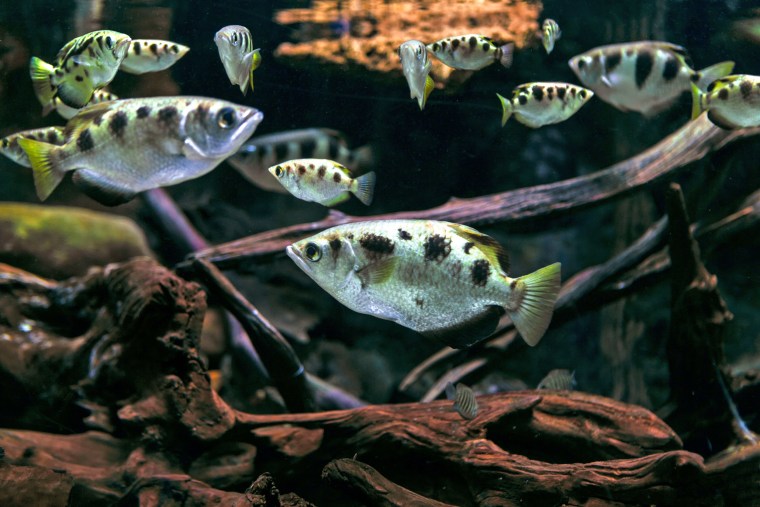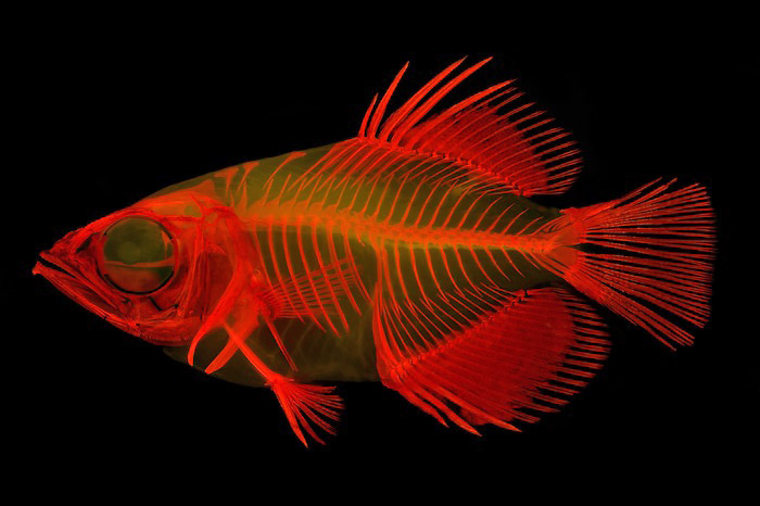Amid the many methods that animals have devised for hunting their prey — the sticky webs that spiders use to catch insects or the fake tasty morsel some turtles display in their mouths — the shooting technique of archerfish stands out.
Sometimes dubbed the “anti-aircraft gunners” of the aquatic world, the tiny archerfish — it’s typically just a few inches long — has evolved such unerring eyesight and precise control that it can shoot down the flying insects it feeds on by spitting out a jet of water from a distance of several feet. The insects then fall into the water, where they can be easily eaten.
Its sharp-shooting abilities are legendary. Studies have shown archerfish almost never miss their target, even though they have to correct their aim for the refraction of the surface of the water they shoot through. And stories from their native India relate that they could extinguish the cigarette of visiting Englishmen who got too close to a river or pond, apparently after mistaking the lit end for a glowing insect.
Just how archerfish could have evolved such a bizarre trait, however, has long puzzled scientists. A new study suggests it’s been developed from jets their ancestors used underwater to clear away sediments in their search for anything edible.
And it shows how even the most extreme natural actions can result from ordinary evolution.

“We knew about this behavior, the spitting mechanism,” said Matthew Girard, an ichthyologist at the Smithsonian Institution in Washington who began the research while studying for a doctorate at the University of Kansas. “It was a question of, how did that evolve? What happened that led to something so incredible?”
Girard is the lead author of a study, published last month in the journal Integrative Organismal Biology, that described the shooting mechanism of the archerfish and attempted to explain how it could have evolved such a trait.
By acquiring specimens and tissue samples of the fish from museums and other institutions around the world, Girard and his colleagues determined that there are at least nine different species of archerfish, although only two are widely known as popular pets in aquariums.
They found that all of them can shoot down insects with jets of water, apparently by concentrating the water in a “blowpipe” structure they form in their mouths using a combination of bones and soft tissues.
Girard noted that there has been debate for almost 100 years as to whether the archerfish’s precise water jet is caused by such a blowpipe structure or whether it’s caused by a “pressure tank” structure in the mouths of the fish — and the new research argues for the blowpipe hypothesis.
The researchers also looked at related species, notably a fish called the beach salmon that belongs to a “sister group” of the archerfish and lives in the Pacific Ocean.
They found that beach salmon, too, had forms of the necessary bones and tissue structures, but they didn’t use them for shooting down prey. Instead, beach salmon use them for chewing up the well-armored organisms they feed on, such as shrimp and other crustaceans, and this purpose seems to be the origin of the same structures in archerfish, Girard said.
It now seems archerfish may have developed their shooting abilities by evolving the existing structures in their mouths, perhaps originally to generate a jet of water that they used to clear away sediment from edible organisms on a lake or riverbed — a technique they still use today.
Modern archerfish often live in places where there is vegetation overhanging the water surface, such as mangrove forests, he said. And it now seemed the archerfish had evolved its shooting abilities in these environments, he said.
“There’s an abundant food source there,” he said. “Insects are some of the most abundant things on Earth, and they took advantage of that.”
Miriam Ashley-Ross, a professor of biology at Wake Forest University, has studied the behavior of archerfish but wasn’t involved in the latest research.
“It’s a pretty ambitious study,” she said in an email. While she agreed that the data presented in the new study suggests the water jet of the archerfish is explained by the blowpipe hypothesis, she’s not convinced that the similar structures in the related beach salmon are used to make underwater jets.
“There are plenty of other fish that can jet water from their mouths,” she said, notably in some species of triggerfish, which use jets of water to overturn sea urchins so they can eat the soft surface underneath.
“It would be great to know if there are similar mouth morphologies in the widely separated fish taxa that can all make underwater jets,” she said.
